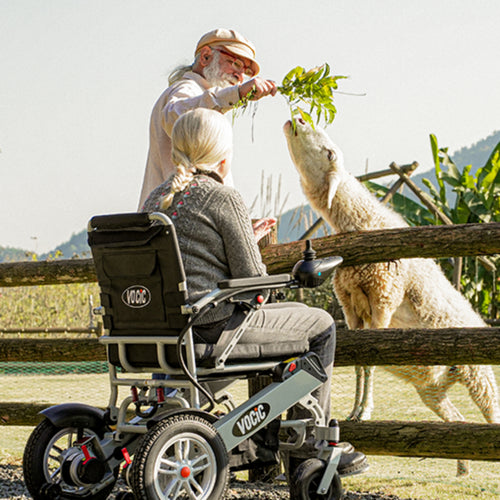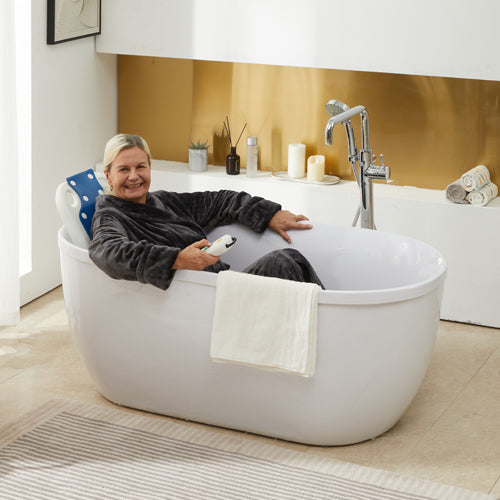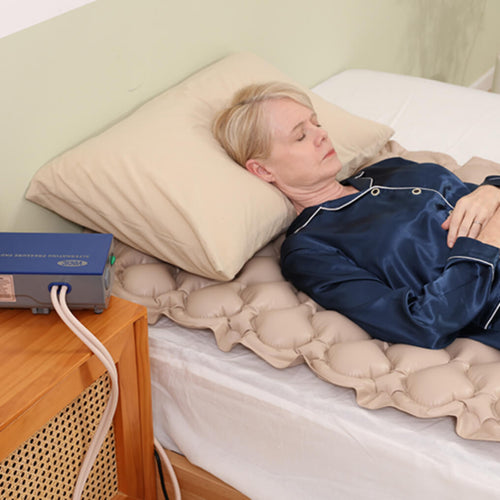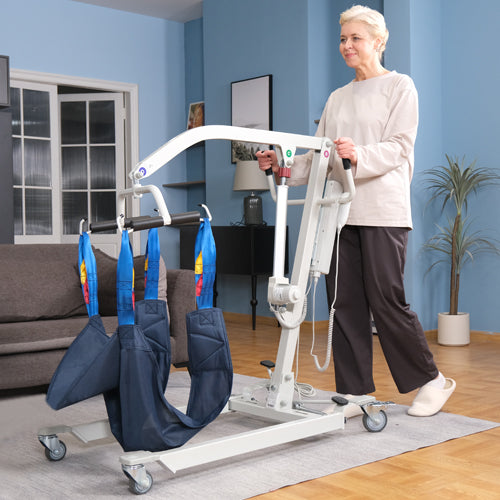As much as folding mobility scooter offer liberation, they also present challenges, particularly when faced with adverse weather conditions such as rain. The question arises: Can you ride your electric scooter in the rain? The answer is yes! You can drive a mobility scooter in the rain, but it is generally not recommended.
In this article, we will delve into the implications of driving an electric scooter in the rain, address concerns, offer tips for optimal safety, and explore the various factors to consider when venturing out in wet conditions.
Can You Drive a Mobility Scooter in the Rain?

Yes! You can drive a mobility scooter in the rain. However, it is generally not recommended for many reasons.
Most mobility scooters are designed to withstand light rain or other mild inclement weather. Driving in heavy rain, flooded areas, or deep puddles can potentially damage the electronic components of the scooter. It must be noted that not all models are equal and may not offer water-resistant features. So, it is crucial to consult the manufacturer's guidelines for accurate information regarding their scooter's capabilities.
It is important to consider the safety implications of using a mobility scooter in the rain. Wet surfaces can be slippery, making it more challenging to maintain control and balance while operating the scooter. This increases the risk of accidents and potential injuries. Additionally, rain can impair visibility for both the scooter operator and other motorists, further compromising safety.
Ultimately, the decision to use a mobility scooter in the rain should be made cautiously, taking into account the potential risks and individual circumstances. It is recommended to consult the manufacturer's instructions and consider alternative transportation options when encountering inclement weather.
Precautions for Driving a Mobility Scooter in the Rain

When faced with the need to use a mobility scooter in rainy conditions, it is crucial to follow certain precautions to ensure both personal safety and the longevity of the device. Here are some important measures to consider:
1. Check The Manufacturer's Guidelines
Review the manufacturer's instructions or user manual specific to your mobility scooter model. It may guide whether the scooter is suitable for use in wet weather conditions and offer any additional precautions or limitations.
2. Invest in Water-Resistant Accessories
Consider purchasing water-resistant accessories to protect both yourself and your mobility scooter from the rain. These may include rain cover for mobility scooters, ponchos, or waterproof seat covers. Such accessories can help shield you and your device from direct exposure to moisture.
3. Maintain a Slow and Steady Pace
Reduce your speed and practice caution when driving a mobility scooter in wet conditions. Wet surfaces can become slippery, decreasing traction and increasing the risk of skidding or losing control. Adopting a slower pace can mitigate the chances of accidents or falls.
4. Ensure Proper Visibility
Rain can affect visibility for both the scooter operator and other vehicles on the road. To maintain clear visibility, use windshield wipers, if available, or carry a small towel or cloth to periodically wipe away rain droplets from your glasses or scooter screen. Having a clear line of sight is essential for safe navigation.
5. Consider Additional Lighting
In rainy or low-light conditions, it is important to enhance the visibility of your mobility scooter. Attach additional reflectors or lights to the front and rear of your scooter to make yourself more visible to other road users and reduce the chances of accidents.
6. Dry the Scooter Properly
After using the mobility scooter in the rain, take the necessary steps to dry it thoroughly. Wipe down the scooter's surfaces to remove any residual moisture that could potentially cause damage. If water has entered any electrical components, consult the manufacturer or a professional for proper inspection and maintenance.
By following these precautions, individuals can minimize the risks associated with using a mobility scooter in the rain, ensuring their safety and prolonging the lifespan of their devices. However, it is important to remember that the decision to use a mobility scooter in adverse weather conditions should be made based on personal comfort and assessment of the risks involved.
Click to learn: top 6 mobility scooter issues
Are Mobility Scooters Waterproof?

The answer to whether mobility scooters are waterproof is not straightforward, as the waterproof capabilities of each model can vary significantly. While most mobility scooters have water-resistant features, while some are not explicitly designed to operate in or withstand heavy rain or wet conditions.
It is crucial to check the manufacturer's specifications and guidelines for precise information concerning waterproofing. Many modern mobility scooters have water-resistant features such as sealed electronics and waterproof motor controllers, which help to protect critical components from moisture exposure.
However, it is worth noting that many battery-operated mobility scooters tend to be vulnerable to water damage. Exposure to excessive moisture can cause short circuits that can lead to costly repairs, reduce the lifespan of the device, or pose an immediate safety risk.
What if My Mobility Scooter Gets Wet?
When a mobility scooter encounters water, the porous surfaces of the device can absorb moisture. Over time, this can cause corrosion to build up on the electrical components, which could impede their ability to function properly. Moreover, exposure to water can significantly compromise electrical systems, including batteries, electronic controls, and wiring. This could impact the overall performance and longevity of the mobility scooter and even pose immediate safety risks.
So, if your mobility scooter gets wet, it is important to take immediate action to minimize any potential damage to the device and ensure your safety. Here are some steps you can take:
- Power off the mobility scooter: Turn off the mobility scooter as soon as possible to prevent any potential electrical issues caused by water exposure.
- Dry the mobility scooter: Use a towel or cloth to dry all surfaces of the mobility scooter thoroughly. Pay attention to areas where water may have collected, such as the seat, controls, and undercarriage. Avoid using any heat sources, such as a hairdryer, to dry the mobility scooter, as this could damage sensitive components.
- Remove excess moisture:If there is standing water on or in the mobility scooter, carefully tilt or shake the device to remove as much excess moisture as possible.
- Allow the mobility scooter to dry completely: After wiping down the mobility scooter, leave it in a dry and well-ventilated area for at least 12 hours and allow it to air dry completely. Depending on the amount of moisture present, this process may take several hours.
- Inspect for damage: Once the mobility scooter is dry, inspect it carefully for any signs of damage, such as rust, corrosion, or electrical issues. Pay attention to any unusual sounds or changes in performance that may indicate problems.
- Seek professional help: If you notice any significant damage after the inspection, it is best to seek help from a professional. The manufacturer or a qualified repair technician can provide specific guidance based on the model and the extent of the damage.
To prevent water or moisture from entering the charging port of your mobility scooter, always remember to securely close the port when it is not in use. Keeping the charging port sealed when not actively charging the scooter can help protect the electrical components from potential water damage and ensure the longevity of your device. By forming this simple habit, you can maintain the safety and performance of your mobility scooter for years to come.
Frequently Asked Questions
1. How can I determine if my electric scooter is waterproof?
To gauge the water resistance of your electric scooter, examine its IP (Ingress Protection) rating. This rating comprises two digits, with the second digit signaling the degree of water protection. Opt for scooters with an IPX4 rating or greater, as they provide sufficient resistance against splashes and light rainfall.
While no scooter is entirely waterproof, it's best to avoid submerging it or subjecting it to heavy downpours. For detailed water resistance information and tailored recommendations, refer to the manufacturer's specifications and guidelines.
2. Why won't my scooter start after it rains?
If your scooter won't start after it rains, the problem likely lies with water affecting its crucial components. The carburetor, which mixes air and fuel for combustion, could be flooded with water, preventing proper fuel ignition. Additionally, essential electrical parts like the ignition system could have been short-circuited by water, disrupting the scooter's ability to start. Ensuring these components are dry and free from moisture can help solve the issue.
Conclusion
While it is technically possible to use a mobility scooter in light showers, it is generally not recommended due to the potential damage to electronic components and increased safety risks. Wet surfaces can be slippery, making it difficult to maintain control, and impaired visibility further compromises safety.
Prioritizing safety and following manufacturer guidelines is crucial to ensure optimal use and protect the longevity of your mobility scooter. If your scooter gets wet, dry it using a towel, remove the moisture, and leave it for at least 12 hours before your next use to allow water to evaporate from the unseen spaces.
Please visit the VOCIC website, they offer many types of mobility scooters for you to choose from.









